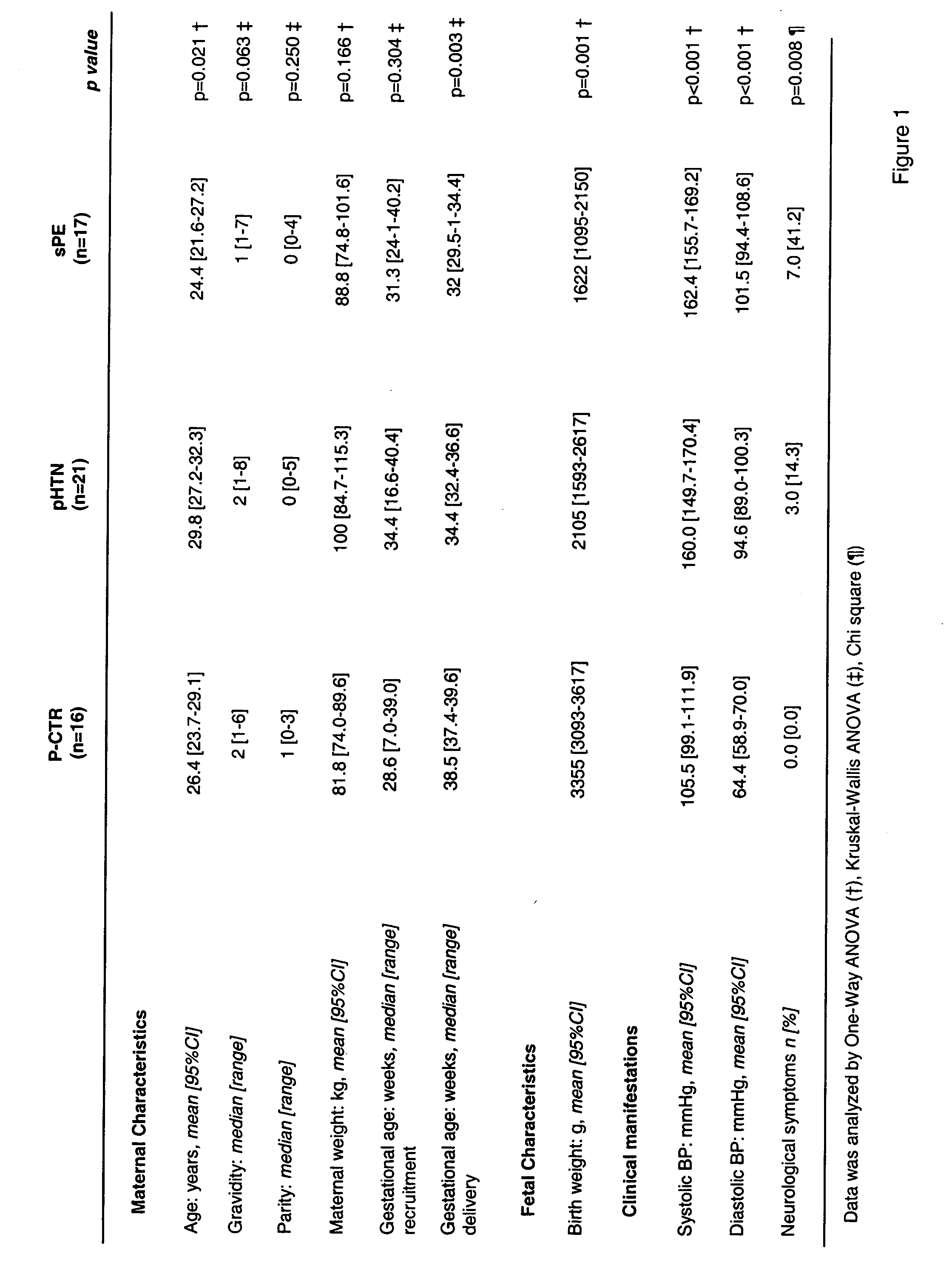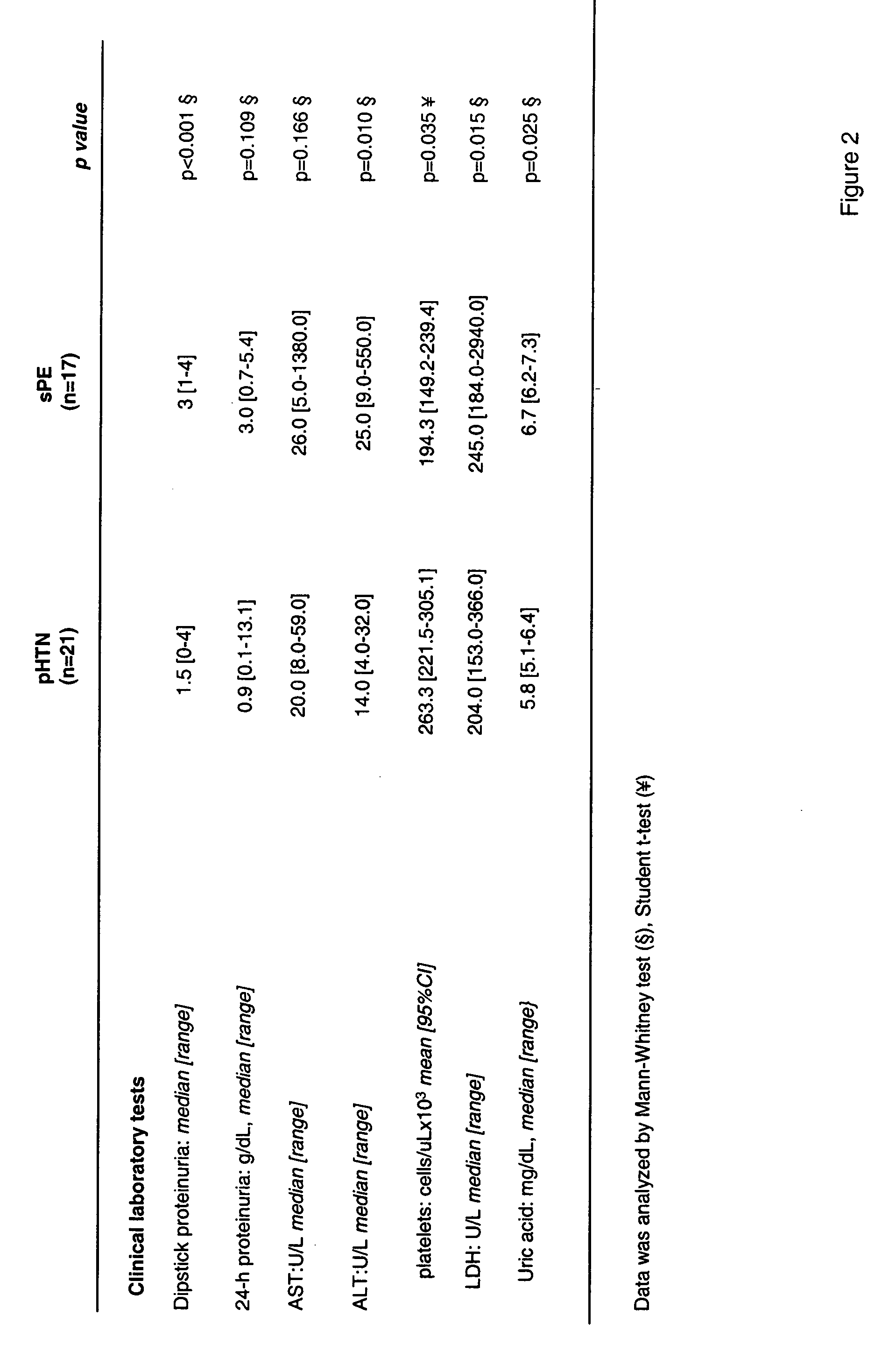Diagnosis of preeclampsia
a preeclampsia and diagnosis technology, applied in the field of diagnosis of preeclampsia, can solve the problems that the excretion of urinary angiogenic factors has not been studied befor
- Summary
- Abstract
- Description
- Claims
- Application Information
AI Technical Summary
Benefits of technology
Problems solved by technology
Method used
Image
Examples
example 1
Increased Levels of sFlt-1 and Decreased Levels of PlGF in Pregnant Women with Hypertensive Disorders.
Participants
[0054] Samples of urine from 68 women admitted at Yale New Haven Hospital between February and August 2004 were utilized. Samples were collected under protocols approved by the Human Investigation Committee of Yale University. Written informed consent was obtained from all participants. Gestational age was established based on menstrual date and / or ultrasonographic examination prior to 20 weeks gestation. All women solicited for enrollment in the study agreed to participate. Applicants requested enrollment from pregnant women admitted to Labor and Delivery ward, and to the antepartum High and Low Risk Units and enrolled patients prospectively. None of the enrolled patients were excluded from the final analysis.
[0055] The following groups of women were tested: severe preeclampsia (sPE, n=17), hypertensive / proteinuric disorders associated with pregnancy that did not m...
example 2
Degradation of sFlt-1 and VEGF in Urine Samples
[0065] Experiments were conducted to test the stability of the angiogenic factors in urine. Eight urine samples from patients with preeclampsia were tested (i) as described herein as urine samples or (ii) after a 24-hour period at room temperature. FIG. 4 below shows the analysis of agreement between the ELISA data of the two samples using the Bland-Altman method of agreement. This analysis plots of the differential value between the two measurements (bias) against their average to assess if the differences between the two techniques are important, whether the two methods may be used interchangeably and whether variability of the differences increases as the magnitude of the measurement increases. The results demonstrate that the largest loss in immunoreactivity is for sFlt-1 (FIG. 4A: average: 57.5 pg / mL) followed by VEGF (FIG. 4B: average: 41.1 pg / mL). For PlGF (FIG. 4C) the negative bias (−8.8 pg / mL) is suggestive that after 24 h a...
example 3
Urinary Ratio sFlt-1 / PlGF
[0066] As discovered herein, normal pregnancy is characterized by an increased urinary PlGF excretion, while hypertensive states are characterized by increased sFlt-1, but decreased urinary PlGF. FIGS. 5A-5B below shows representative ELISA experiments that demonstrate the effect of such hypertensive states on (A) sFlt-1 levels in pregnant women and (B) PlGF levels in pregnant women. In view of this, applicants reasoned that urinary sFlt-to-PlGF (uFP) ratio would be a better indicator of individual urinary homeostasis of angiogenic markers. The ratio indicator was computed using the following formula: uFP=log[sFlt / PlGF×100]. FIGS. 5C-5D below show (C) a representative spreadsheet used for the calculation of uFP from the ELISA data presented herein and (D) mean (+SD) uFP of patients with sPE versus P-CTR. Results of such calculations demonstrated that uFP was significantly elevated in women with sPE compared with pHTN (Student-Newman-Keuls, p=0.008), P-CTR ...
PUM
| Property | Measurement | Unit |
|---|---|---|
| volumes | aaaaa | aaaaa |
| pressure | aaaaa | aaaaa |
| concentrations | aaaaa | aaaaa |
Abstract
Description
Claims
Application Information
 Login to View More
Login to View More - R&D
- Intellectual Property
- Life Sciences
- Materials
- Tech Scout
- Unparalleled Data Quality
- Higher Quality Content
- 60% Fewer Hallucinations
Browse by: Latest US Patents, China's latest patents, Technical Efficacy Thesaurus, Application Domain, Technology Topic, Popular Technical Reports.
© 2025 PatSnap. All rights reserved.Legal|Privacy policy|Modern Slavery Act Transparency Statement|Sitemap|About US| Contact US: help@patsnap.com



